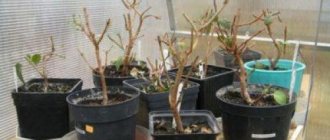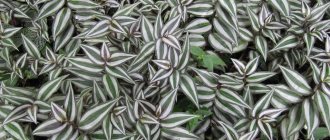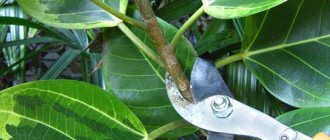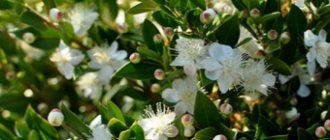Pruning indoor plants is one of the important care items. And the most individual. There are indoor plants that are not pruned at all, while others require regular trimming. There are a variety of tasks before pruning. It can come down to removing dry or damaged parts, or it can become the basis for a beautiful silhouette, stimulate more luxuriant flowering or rejuvenation. It is impossible to maintain the compact size and healthy condition of indoor crops without pruning. And although there is nothing complicated in it, you should not forget about the individual approach and adhere to general norms and rules.
Pruning indoor plants
A little about myths.
The first and probably the most important myth: you can’t prune, because the flower will be “hurt” (or unwell). It is very difficult to refute this opinion, since people by their nature tend to humanize the world around them. But as we know, plants do not have a nervous system (like humans), and not a single serious study has shown that plants are capable of feeling anything. Therefore, they cannot “love”, “prefer”, etc. And besides, very often plants acquire an unattractive shape from improper care. Therefore, if you have a lopsided or elongated plant, which in your opinion “loves” the way you care for it, then perhaps you should read again about the recommended methods of care? The second myth is that if you cut off the growing point, then the plant will die. In fact, there are very few such plants. Now I can only remember the Arekov family. All other plants (dracaenas, yuccas, euphorbias, ficuses, etc., including orchids) can be pruned as you personally want. The third myth is that if you prune a plant, it will hurt. Anything that makes the crown unattractive can be cut off from almost any plant. It will not die or get sick from this. Naturally, subject to the necessary care. And I will write below about when and what to cut off.
Don't leave flowers without water
designmom.com
Water keeps flowers alive. The longer the flowers remain without water, the less they last. Therefore, if you buy flowers yourself and want to preserve them longer, listen to these three recommendations:
- Ask to pack the bouquet in an individual container with water.
- Take a container of water with you so that you can immediately place the flowers in it after purchasing.
- Wrap the base of the stems in damp paper towels.
How to properly prune a houseplant. Some terms.
The growing point is the tip of the shoot. This is where new leaves grow from. A node is the place of the shoot to which the leaf is attached (or was previously attached if the leaf is no longer there). New branches can grow from nodes.
Nodes
Internode - the area of shoot between the nodes. No further growth is possible at this point. Pinching is the removal of a bud at the end of the shoot, i.e., the growth point.
How to properly prune a houseplant. General rules.
The most optimal time for pruning is the beginning of the growth period, that is, the last days of February or all of March. Of course, you can trim at other times. But in summer the plant can bloom. Autumn is preparation for the rest period. A pruned plant can awaken its buds only in the spring. Accordingly, there is a risk that the flower will remain in the form of a “stump” for about six months. But in general, you can also prune in the fall. In winter, the plant should rest. Pruning in some cases encourages growth. Accordingly, natural rhythms are disrupted.
There are plants that, after pruning, easily form sloppy bushes. First of all, these are trees with a rosette growth form, for example, Schifflera, Dieffenbachia and the like. Although experienced gardeners are quite successful in pruning them, most often it is recommended to update such plants periodically. That is, cut the cuttings, root them, and grow new young plants. With this method, the old overgrown bush is thrown away. An alternative would be to trim it very short. In this case, you need to cut off almost the entire above-ground part of the flower, leaving a stump 3-5 cm in height. Then 1 or 2 new shoots grow from it. As a result, the plant will look young.
Pinching (pinching)
The simplest of all types of pruning is pinching (or pinching young shoots), which amounts to removing the apical buds and buds located at the tip of the shoots when they reach the length you need. This procedure is carried out throughout the entire period of active growth of the plant in order to form the shape you need or improve the quality and intensity of flowering. For some flowering plants, this procedure prolongs their flowering period and improves their decorative appearance. For young shoots, in order to increase the growth of new branches, we pinch the shoots regularly, taking into account that this method is suitable for plants characterized by rapid growth. There are plants whose buds emerge near the pinching site; if you don’t need these shoots, remove them.
Pinching (pinching)
Tweezing has several tasks:
- pinching helps awaken dormant buds;
- a simple method that does not injure the plant itself;
- enhances the growth of the main stem and promotes branching.
Shortening shoots differs from pinching in that in this case the length of the shoot itself or its branches is reduced. If severe shortening occurs, then dormant buds awaken on the cut branch and lateral branching occurs, which prevents the plant from stretching upward. This method is suitable for climbing plants.
What branches can be cut off?
Pruning is done to ensure that the crown is beautiful in the future. Very often, flower growers prune so that it is beautiful “here and now.” At the same time, they do not pay attention to where the kidneys are directed. This approach leads to the fact that after a month the plant loses its decorative qualities. Therefore, before pruning, decide what exactly you want to get in the end. It is quite possible that it will be enough for you to thin out the bush a little or cut off an overgrown shoot. Notice the branches that grow parallel to each other. Almost always this makes the crown not beautiful. Depending on the situation, one of these branches can be cut off to the base, or cut off near a bud that “looks” in the other direction. Naturally, you decide what to do. In addition, branches that grow inside the crown or are directed in a direction different from the growth of most other shoots (up or down) make the bush unattractive. They also need to be either cut off altogether or trimmed to a bud pointing in the right direction. That is, in accordance with your personal understanding of future development and aesthetic taste.
Parallel shoots
The shoot grows upward, thereby making the bush sloppy
Feed the flowers
Once the flowers are cut, they no longer receive nutrients from the soil. And this becomes our concern if we want to prolong their life.
At any flower shop you can purchase a special powder for preserving freshly cut flowers. You can add a little baking soda to the nutrient powder (¾ teaspoon per liter of water). This will help keep the water clean and clear and slow down the formation of bacteria and microorganisms harmful to flowers.
Just don't overdo it with baking soda, otherwise you'll ruin the flowers you really want to preserve.
Formation of a bush-like crown in Ficus Benjamin. Personal experience.
If you have read my previous articles, you will probably recognize my ficus) Its crown has grown in one plane. There are branches whose growth direction makes the bush ugly. In addition, it was originally planned (if you remember) that the plant would be a compact tree. Ficus benjamina is a wonderful, unpretentious plant on which you can practice pruning. Even if you cut off a branch, and later see that it was a wrong decision, you can always correct it.
Trimming.
First, I will prune the branches whose growth direction is contrary to the general rules. I don’t want to cut them out completely, just half them. After all, I plan that the bush will be more or less voluminous, and not, as it is now, in one plane. Since I don't want the plant to grow excessively upward, I cut off the top. In addition, there are parallel branches. In this way I will get rid of this shortcoming. Now let's examine the bush from all sides and determine what else will interfere with the formation of a beautiful bush. After that, I will trim the branches that, in my opinion, have excess growth. This is what happened in the end.
A few important points
To prune plants, you need to use a quality tool. Secateurs or garden shears must be sharp and clean. During operation, the tool also needs to be disinfected so as not to transfer diseases from one plant to another. This will allow minimal damage to the plants when pruning. It is advisable that the branches are cut in one motion, and the cut areas can be treated with special preparations if necessary.
There is no need to rush into pruning perennials, as this may cause dormant growth points to awaken in some of them. And this is extremely dangerous for the plant, since with the onset of frost, not only vegetative shoots, but the entire plant can die.
All plant waste resulting from pruning should be burned or removed from the site. This is necessary so that diseases and wintering pests that may be on them do not infect young healthy shoots in the spring.
Trimming result.
My ficus has sprouted many new shoots and grown a fair amount of foliage. Pruning and subsequent correction of the crown using pinching made it possible to ultimately obtain a voluminous, compact and beautiful plant. That is, all the tasks that stood before me were solved. Now it is necessary to periodically adjust the crown by pinching and (possibly) pruning. Similarly, you can form the crown of any other plant. After all, they all develop in a similar way.
Good luck to you and your plants!
Subscribe to our channel on Telegram
Remove any wilted petals and leaves
designmom.com
To keep the water in the vase clean and fresh longer, remove all rotten leaves and petals. Particularly carefully clean the part of the stem that will sink into the water.
Leaves in water promote the formation of bacteria that are harmful to flowers. Moreover, when the leaves fall into the water, it becomes cloudy and acquires a putrid odor.











